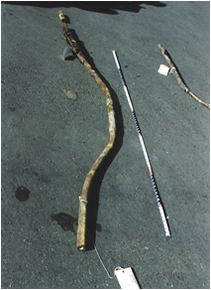Natural Gas Explosion

Figure 1. Kinked gas line |
Late at night, a single family detached home in a residential neighborhood suffered an explosion and fire. The fire continued until the source of the fuel was discovered – a natural gas leak from a ½ inch diameter polyethylene tube; it was a lateral from the main line. Why did the tube suffer a leak, how did the natural gas end up in the home undetected, and what ignited the blast and fire?
Excavation of the tube revealed that the failure occurred at a fitting that increased the size of the tubing from ½ inch diameter to 1 inch diameter. The ½ inch diameter tube had pulled out of the fitting intact – the fitting had failed. Further excavation exposed a length of 1 inch diameter steel pipe. The ½ inch polyethylene tube had been sleeved inside of the steel pipe as part of a recent gas utility upgrade and repair. Even more recent was an upgrade to the neighborhood sewer main. Months prior to the explosion, crews had excavated along the street taking care not to disturb other utilities in their path, however they did accidentally strike the steel gas line, creating the kink seen in Figure 1. But the crew was unaware of the sleeved polyethylene tube inside; no gas leak was detected and it was thought that the line was abandoned, so the crew just moved on.
What the crew did not realize at the time was that the lateral kink in the steel pipe had introduced a significant tension load to the sleeved polyethylene tube. Over time this load slowly pulled the tube out of the nearby fitting. Our analysis and testing found that the fitting was defective – fittings are designed to withstand any load imparted to them from the attached tubes. Under excessive load, the tube is supposed to fail first, not the fitting. That was not the case here. The tension that had built up from the kink was slowly relieved as the polyethylene tube pulled free of the fitting. Subsequent changes to the fitting mitigated this design defect.
The now leaking natural gas migrated underground along the annular space between the soil and the buried gas tubing eventually crossing the sewer trench and finding its way under the home and inside the walls. By this time the odorant had been scrubbed away by the soil, allowing the gas to collect unnoticed. The air and gas mixture reached its explosive limit and the flip of a light switch by the returning homeowner sparked the explosion and fire.
